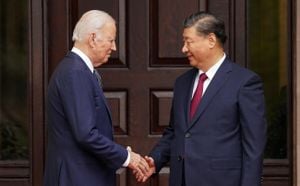A wave of violence has enveloped Beirut, spurred by Israeli airstrikes on densely populated neighborhoods. The most recent attacks, occurring on November 18, 2024, have resulted in at least five fatalities, with the Lebanese health ministry reporting injuries to over two dozen others. This marked the third Israeli attack within two days on the heart of the Lebanese capital, with prior strikes on nearby areas claiming multiple lives, including those of key Hezbollah officials.
The Lebanese Ministry of Public Health detailed the incident involving the most recent airstrike, emphasizing the chaos and destruction inflicted on the working-class district of Zuqaq al-Blat. The strikes reportedly targeted residences near significant Shiite Muslim sites, creating pandemonium among the local population as emergency services rushed to aid survivors trapped beneath the rubble.
According to the official National News Agency of Lebanon, the strike occurred without prior notice, leaving residents vulnerable as the bombs fell. Witnesses described the chilling scene of explosions and flames consuming buildings. “I was asleep and awoke from the sound of the strike, and people screaming, and cars and gunfire,” shared local resident Suheil Halabi, encapsulating the fear gripping the city.
Hezbollah has confirmed the loss of its spokesman, Mohammed Afif, who was killed during the prior day's air raid on the office of the Arab Socialist Baath Party, highlighting the increasing scale of Israeli operations targeting the militant group's leadership. Alongside Afif, four other members of Hezbollah's media team were also reported dead. This high-profile casualty, alongside the surge of Israeli airstrikes, marks escalation not seen since the prolonged violence between Israel and Hezbollah reignited earlier this fall.
This return to heightened conflict follows nearly 14 months of skirmishes ignited by Hezbollah’s support for Hamas during the crisis over Gaza. The situation has shifted dramatically, with Israel ramping up its air campaign in Lebanon as of late September 2024. Lebanese authorities now claim over 3,500 people have died due to the increased exchanges of fire with Hezbollah since the start of the year, indicating the widespread human cost of this enduring conflict.
While the streets of Beirut turn from lively markets to chaotic ruins, the backdrop of international negotiations persists. Amid the violence, discussions surrounding ceasefire proposals backed by the United States continue. A Lebanese government minister recently hinted at “a very positive view” toward proceeding with such discussions, showing the complex interplay between military actions and diplomatic efforts.
The relentless bombardment has not only claimed lives but has also disrupted daily life; schools and educational institutions have been ordered closed for safety. Residents are grappling with the newly imposed realities forced upon them by the strikes—homes rendered uninhabitable, people displaced, community centers transformed from hubs of activity to mere shelters from the violence overhead.
Adding to the chaos, following the missile strikes from Lebanon, Israeli military reports state they intercepted over 100 projectiles fired by Hezbollah. Civilians caught on both sides face the brunt of this military confrontation; one tragic incident in northern Israel left one woman dead and several others injured amid the tumultuous exchanges.
With the city of Beirut reeling from the recent bombings, the air is thick with uncertainty and fear. Local businesses, like those owned by resident Shukri Fuad, face devastation, with many having lost everything to the flames sparked by airstrikes. “We lost our whole life's work,” she lamented, encapsulating the doom felt by many.
Hezbollah's response to the Israeli campaign has been one of fierce resistance, as they vow to continue their defense against what they term the “aggression” from their neighbor. Despite the numerous diplomatic channels being explored, including the recent US-led ceasefire suggestions, the ground reality remains harrowing and uncertain.
Analysts warn this could morph from escalated military operations to widespread humanitarian crises, as the availability of resources and safe havens diminishes rapidly. Children, families, and displaced individuals face dire conditions, described by some as on the brink of collapse.
On the international stage, the narrative is gaining attention. The developments relating to Hezbollah and Israel's interactions have provoked discussions on global security, the efficacy of international diplomacy, and the immediate humanitarian needs of the population caught between these opposing forces.
Information continues to pivot between reports of Israeli airstrikes, Hezbollah retaliations, and civilians caught unawares, and as the dust settles on the latest attacks, many observers are left wondering: how far will this deadly exchange continue, and at what cost to the innocent civilians caught within its throes?
With tensions high and the region on edge, the world watches anxiously, hoping for resolution, yet fearing the escalation could lead to more devastation as military strategies clash against the backdrop of deeply rooted animosities.



